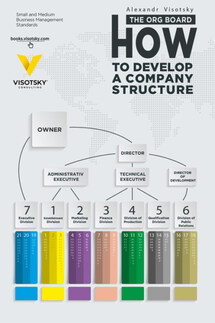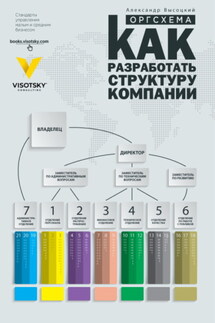The org board. How to develop a company structure - страница 6
Take a crew of house painters as an example. A foreman will plan, assign tasks, ensure that the work gets done, coordinate the actions of the team with other departments, and perform many other functions. This activity is the "doingness". The VFP of a worker in his crew is obvious: painted walls. He has several workers who produce this VFP and he, as manager, is running the activity. His own VFP is the VFP of all the workers as a whole, i.e. the VFP of the whole crew. Once this is understood, it is not difficult to formulate his VFP as, "professional quality painting jobs completed on time". The foreman’s customers are expecting this product and willingly pay specifically for that. If a foreman can't get that VFP through executive actions, such as orders or assigning tasks, he simply picks up a brush and begins to paint the walls himself. He could at least achieve the crew’s VFP in that fashion.
In a similar vein, if the head of a company cannot get the company’s VFP produced through executive means, he rolls up the sleeves and finds customers, makes sales, creates advertisements, handles unhappy customers, etc. He does all this because he is responsible for the VFP of the company as a whole. Executives, as a rule, are responsible people, and, quite often, experts in the area they manage. Unfortunately, their expertise thwarts their ability to be good executives, and instead of learning and using management tools, they do the work of their juniors. It may seem very responsible to take the initiative and show an employee how to do the work. But in that moment when the executive demonstrates his wall-painting mastery, nobody is doing the job of the executive… Usually, an executive can replace his juniors, but not vice versa.
Imagine the foreman of a crew of a couple dozen painters, and, instead of ensuring productive and well-coordinated work, he personally takes a brush to the wall. Good control of workers can significantly increase the crew’s performance, compared to simply being an extra pair of hands. A competent sales manager with five salespeople in his department can significantly increase the sales volume if he plans the work out, sets targets, supervises the work, corrects errors, and demands results rather than personally closing the sales.
If you understand this principle, you can even determine whether the person you want to hire would make a good executive. Just ask him what he thinks his VFP as an executive is, and find out how well he understands the tools he should use as an executive to produce that product.
If you are the owner or the CEO of a company, your product is the VFP of your entire company. And that helps assess your own performance. For example, my main VFP as the founder of Visotsky Consulting is management tools implemented in our clients’ enterprises. If my company implements them correctly, it leads to the expansion of their businesses, which means that I produce my product. If my company takes on a project and does not accomplish that result, I have not produced the VFP.
Determining the VFP of your business is quite simple. It's the specific product or service for which your customers pay you money. If the business deals with window manufacturing and installation, the CEO’s VFP can be stated as, "windows of high-quality manufactured and installed". Of course, you need to clearly understand what the client is paying you money for. As an example, what do customers pay money for at a restaurant? Delicious food, atmosphere, speedy service, and a convenient location. Look at several restaurants, and you will find that they have completely different VFPs. There are restaurants that boast famous dishes where clients will travel great distances and reserve a table months prior just to eat there. There are restaurants known for their special ambiance, and restaurants where you expect to eat quickly.









